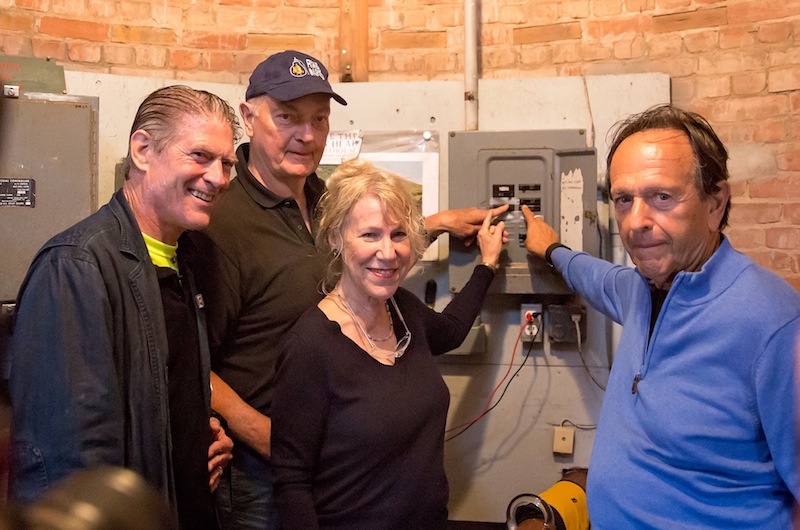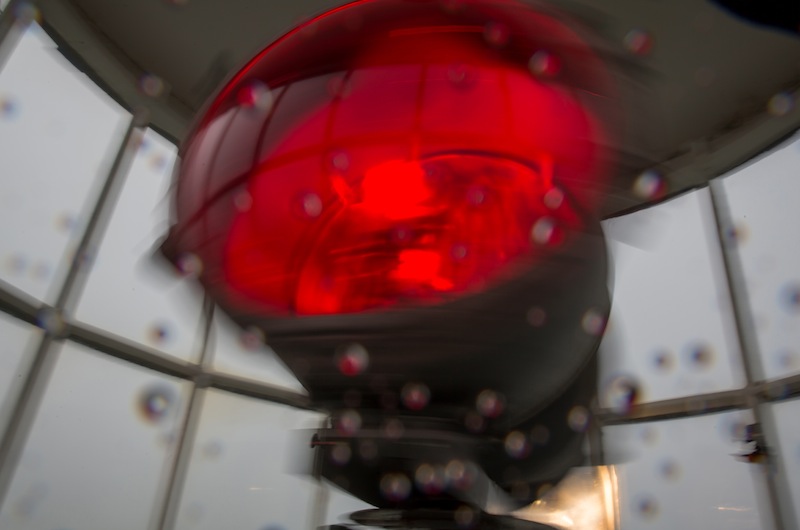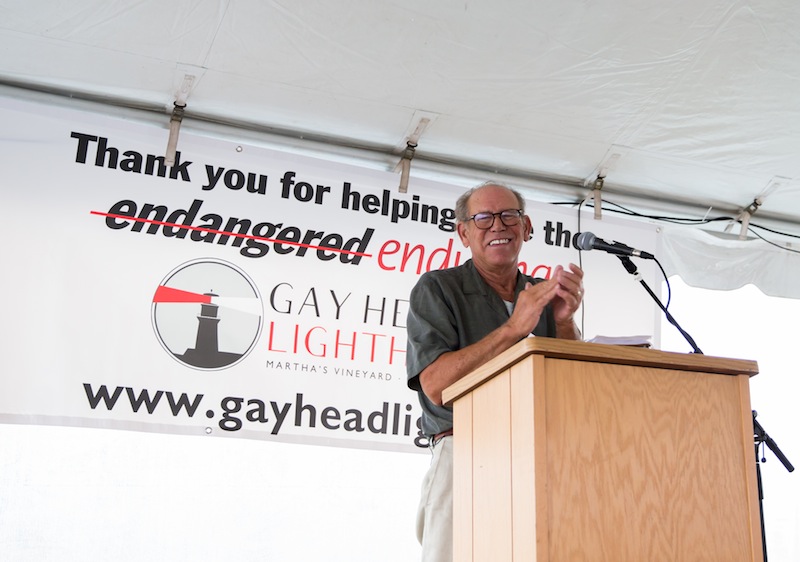Under a steady downpour on Tuesday, the Gay Head Light resumed its watch over Vineyard Sound and the waters off Aquinnah. A large crowd gathered in Aquinnah Circle, peering up from under their umbrellas and hoods to witness the end of the lighthouse’s longest period of darkness since 1856.
In May, following more than two years of intense preparation and fundraising, the historic brick-and-masonry tower was moved 129 feet from a rapidly eroding cliff. In the weeks that followed, a new foundation and retaining wall were completed, and excavated soil was returned to the site.
By Tuesday, much of the landscaping was complete, including a split-rail fence along the cliff edge, but most of the site remained off-limits to the public.
Donors, government officials and others who helped move the lighthouse to safety gathered under a small tent next to the lighthouse for a ceremony prior to the relighting. Rain pelted the tent and splashed those standing around the edges as speakers offered their thanks and congratulations to the crowd.
“I have not been involved in a transaction that was this special or this meaningful,” said Carol Chirico of the General Services Administration, which oversaw the transfer of the lighthouse from the U.S. Coast Guard to the town early this year. “And that’s because of the people involved and the passion that they have for this lighthouse.”
Along with the National Park Service, the Coast Guard and other agencies, the GSA made record time, hammering out an agreement in just five months and delivering the deed to the town in February.
Elijah Reynolds, chief of the Coast Guard’s Aid to Navigation Team in Woods Hole, which oversaw the relighting, spoke on behalf of Capt. John Kondratowicz of sector Southeastern New England, who had been called to duty during the storm.
“It is perhaps appropriate for this relighting ceremony to take place on the only stormy day in the last 30,” Mr. Reynolds said. “Gay Head Light, after all, was established so mariners could find their way home safely during foul weather.” (A temporary metal beacon at the Gay Head lookout had been struck by lighting in July, blowing off about a third of its concrete base. That beacon was expected to be taken down this week.)
“It is with great pleasure that I, on behalf of the Coast Guard, re-designate Gay Head Light as an active aid to navigation,” Mr. Reynolds said Tuesday, to loud cheers and applause from the crowd.
Lead donor and elder Aquinnah resident Amalie Kass was given the honor of cutting a large red ribbon wrapped around the lighthouse. Family members sheltered her with umbrellas as she stood in front of the open doorway and snipped the ribbon.
Under the tent, saxophonist Scott Shetler played an upbeat rendition of This Little Light of Mine.

People streamed into the lighthouse and up the stairs, where donors Hank Goldberg, Carol Brown Goldberg and Edward Miller awaited the countdown to flip the switch. Photographers and filmmakers followed, crowding into the small control room below the beacon.
As if on queue, most of the town, including the lighthouse, which had been hooked up for electricity that morning, lost power.
Lightkeeper Richard Skidmore leaned over the edge of the balcony near the top of the tower and tried to communicate with those below. Rain blew in through the doorway as people shouted back and forth, creating echoes across the foggy landscaped.
“Talk about anticlimactic,” Mr. Skidmore said.
Finally, the lights came back on, with cheers of relief from the control room. Lighthouse committee member Len Butler, who has helped lead and organize the project, began the countdown over a PA system.
The countdown ended with a loud burst of cannon fire, and the three donors, with three fingers on the switch, restored power to the beacon. At 6:13 p.m., following a 30-second timed delay after the beacon began spinning, the two lanterns came to life, sending red and white beams sweeping through the fog and rain, to loud cheers from below.
“We are lit!” said Mr. Skidmore, who was thoroughly soaked.
The celebration continued under a large tent in the Circle, with music by Wampanoag drumming group Black Brook Singers and local rock band Good Night Louise. Heavy rain roared down on the tent as people danced and visited into the evening. Isaac Taylor performed Red Queen, an original homage to the lighthouse.
On Wednesday, the lighthouse reopened to the public for the first time since April 13.
A steady stream of visitors headed up a temporary wood-chip path to the lighthouse, which is now surrounded by fresh sod and a stone wall to the east. Granite steps leading into the lighthouse had been recovered from the buried foundation of a former lightkeeper’s quarters. Tall evergreen shrubs along the retaining wall helps to shield the view of nearby condos.
“There was a rush to get everything completed for the relighting,” relocation project manager Richard Pomroy said. Salvaged vegetation is still being stored in the Circle and irrigated with sprinklers. Landscope Inc. of Edgartown will likely replant the material in the fall.
A large amount of lead-contaminated soil left over from former buildings is being stored under a tarp and will likely be shipped off-Island in September. The discovery of the contaminated soil, along with endangered plant habitat near the lighthouse, had raised the town’s fundraising goal from $3 million to $3.4 million.
“It has been an incredible outpouring of support from all corners of the Island and way beyond,” Meg Bodnar, co-chairman of the lighthouse fundraising committee, said Thursday. She added: “We are getting close, but we are not at the finish line.”
The Martha’s Vineyard Museum has resumed stewardship of the lighthouse, signing a two-month agreement with the town of Aquinnah to lease and operate the historic building. Prior to the move, the museum had a similar agreement with the U.S. Coast Guard.
“We are basing our plans on about a half a season,” museum finance director Betsey Mayhew said Wednesday. “But we figured there is maybe more interest this year that might draw higher visitation.”
Last year, about 22,000 people visited the lighthouse. About 230 visited on Wednesday, which is about average for this time of year, although the hours have been shortened to accommodate neighbors.
Ms. Mayhew hoped to be able to extend the contract beyond the two months, but as a municipal agreement, it must first go out to bid.
The next phase of the project will be to restore the tower to its original condition. A permanent lighthouse committee has been established in Aquinnah, although its membership is incomplete. Among other things, it will oversee the restoration and work with the museum to coordinate private events throughout the year.
The Gay Head Light was also extinguished in 1989, when the beacon was replaced. That marked the end of the traditional signal pattern of three white flashes and one red, and the beginning of the alternating red-and-white pattern that is used today. Mr. Butler said he remembers the change and how jarring it was for some residents who were accustomed to the light shining into their windows at night.
“We still want three whites and a red back one day, but I don’t know if that will ever happen,” he said by phone on Wednesday. Fortunately for town residents, the relocation has not greatly affected the reach of the light. “Anybody who could see it before can most likely see it still,” Mr. Butler said.
Speaking to the crowd on Tuesday, Mr. Butler expressed his gratitude to all those who braved the weather to celebrate the relighting, and to the many people who made the relocation possible. “We did this for everybody,” he said, before the music and dancing resumed. “It’s a special day that I hope you’ll never forget.”
Mr. Pomroy was elated that the relocation was now complete.
“What a day,” he said Tuesday. “It rained and everything. It was perfect.”
The lighthouse is open daily from 11 a.m. to 4 p.m. through Oct. 12, and Thursdays from 6 to 8 p.m. through Sept. 10.
View historic film clips of the Gay Head Light and the Gay Head Cliffs.









Comments (2)
Comments
Comment policy »